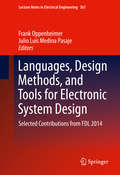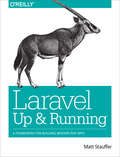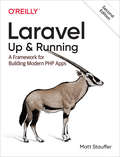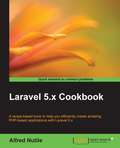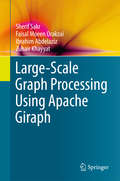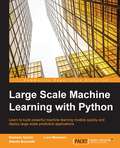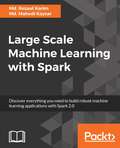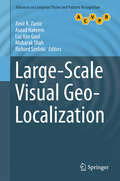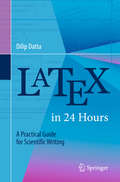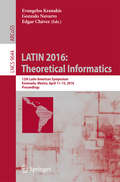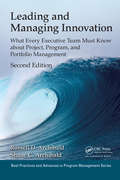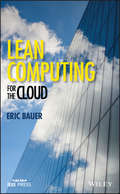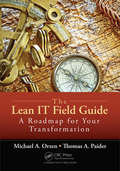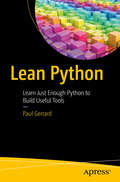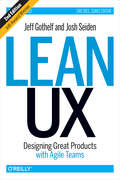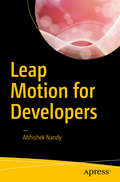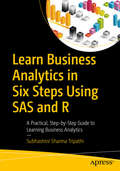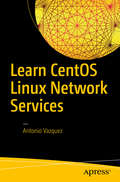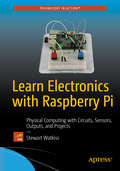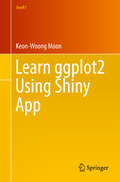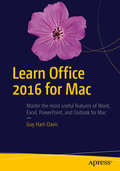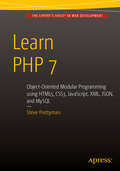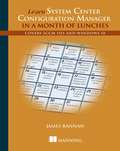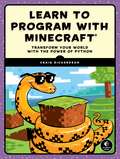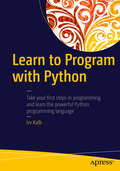- Table View
- List View
Languages, Design Methods, and Tools for Electronic System Design
by Julio Luis Medina Pasaje Frank OppenheimerThis book brings together a selection of the best papers from the seventeenth edition of the Forum on specification and Design Languages Conference (FDL), which took place on October 14-16, 2014, in Munich, Germany. FDL is a well-established international forum devoted to dissemination of research results, practical experiences and new ideas in the application of specification, design and verification languages to the design, modeling and verification of integrated circuits, complex hardware/software embedded systems, and mixed-technology systems.
Laravel: A Framework for Building Modern PHP Apps
by Matt StaufferWhat sets Laravel apart from other PHP web frameworks? Speed and simplicity, for starters. This rapid application development framework and its vast ecosystem of tools let you quickly build new sites and applications with clean, readable code. With this practical guide, Matt Stauffer--a leading teacher and developer in the Laravel community--provides the definitive introduction to one of today's most popular web frameworks.The book's high-level overview and concrete examples will help experienced PHP web developers get started with Laravel right away. By the time you reach the last page, you should feel comfortable writing an entire application in Laravel from scratch.Dive into several features of this framework, including:Blade, Laravel's powerful, custom templating toolTools for gathering, validating, normalizing, and filtering user-provided dataLaravel's Eloquent ORM for working with the application's databasesThe Illuminate request object, and its role in the application lifecyclePHPUnit, Mockery, and PHPSpec for testing your PHP codeLaravel's tools for writing JSON and RESTful APIsInterfaces for file system access, sessions, cookies, caches, and searchTools for implementing queues, jobs, events, and WebSocket event publishingLaravel's specialty packages: Scout, Passport, Cashier, Echo, Elixir, Valet, and Socialite
Laravel: A Framework for Building Modern PHP Apps
by Matt StaufferWhat sets Laravel apart from other PHP web frameworks? Speed and simplicity, for starters. This rapid application development framework and its vast ecosystem of tools let you quickly build new sites and applications with clean, readable code. Fully updated to cover Laravel 5.8, the latest release, the second edition of this practical guide provides the definitive introduction to one of today’s most popular web frameworks.Matt Stauffer—a leading teacher and developer in the Laravel community—delivers a high-level overview and concrete examples to help experienced PHP web developers get started with Laravel right away. By the time you reach the last page, you should feel comfortable writing an entire application in Laravel from scratch.
Laravel 5.x Cookbook
by Alfred NutileA recipe-based book to help you efficiently create amazing PHP-based applications with Laravel 5.x About This Book * Leverage the amazing new features of Laravel 5.x to create cutting-edge responsive PHP applications. * Create apps with interoperability features and extend these features to your existing applications as well. * Over 60 recipes that combine tried and tested Laravel tips for getting your app working. Who This Book Is For The ideal target audience for this book is PHP developers who have some basic PHP programming knowledge. No previous experience with Laravel is required for this book. What You Will Learn * Optimize Your Gulp and Elixir Workflow * Use Travis to run tests with every push * Build and test your view-based route in PHPUnit * Explore workflows for migrations and seeding * Implement Angular in your Laravel applications * Set up a user authentication system * Integrate the new Billing library and Stripe in your Laravel application * Use the Artisan command-line tool * Test your App in Production with Behat In Detail Laravel is a prominent member of a new generation of web frameworks. It is one of the most popular PHP frameworks and is also free and an open source. Laravel 5 is a substantial upgrade with a lot of new toys, at the same time retaining the features that made Laravel wildly successful. It comes with plenty of architectural as well as design-based changes. The book is a blend of numerous recipes that will give you all the necessary tips you need to build an application. It starts with basic installation and configuration tasks and will get you up-and-running in no time. You will learn to create and customize your PHP app and tweak and re-design your existing apps for better performance. You will learn to implement practical recipes to utilize Laravel's modular structure, the latest method injection, route caching, and interfacing techniques to create responsive modern-day PHP apps that stand on their own against other apps. Efficient testing and deploying techniques will make you more confident with your Laravel skills as you move ahead with this book. Towards the end of the book, you will understand a number of add-ons and new features essential to finalize your application to make it ready for subscriptions. You will be empowered to get your application out to the world. Style and approach This book will have a practical recipe-based approach with dedicated recipes on your daily Laravel tasks (as well as on more advanced issues) that will help you become a pro with Laravel 5.x
Large-Scale Graph Processing Using Apache Giraph
by Sherif Sakr Faisal Moeen Orakzai Ibrahim Abdelaziz Zuhair KhayyatThis book takes its reader on a journey through Apache Giraph, a popular distributed graph processing platform designed to bring the power of big data processing to graph data. Designed as a step-by-step self-study guide for everyone interested in large-scale graph processing, it describes the fundamental abstractions of the system, its programming models and various techniques for using the system to process graph data at scale, including the implementation of several popular and advanced graph analytics algorithms. The book is organized as follows: Chapter 1 starts by providing a general background of the big data phenomenon and a general introduction to the Apache Giraph system, its abstraction, programming model and design architecture. Next, chapter 2 focuses on Giraph as a platform and how to use it. Based on a sample job, even more advanced topics like monitoring the Giraph application lifecycle and different methods for monitoring Giraph jobs are explained. Chapter 3 then provides an introduction to Giraph programming, introduces the basic Giraph graph model and explains how to write Giraph programs. In turn, Chapter 4 discusses in detail the implementation of some popular graph algorithms including PageRank, connected components, shortest paths and triangle closing. Chapter 5 focuses on advanced Giraph programming, discussing common Giraph algorithmic optimizations, tunable Giraph configurations that determine the system's utilization of the underlying resources, and how to write a custom graph input and output format. Lastly, chapter 6 highlights two systems that have been introduced to tackle the challenge of large scale graph processing, GraphX and GraphLab, and explains the main commonalities and differences between these systems and Apache Giraph. This book serves as an essential reference guide for students, researchers and practitioners in the domain of large scale graph processing. It offers step-by-step guidance, with several code examples and the complete source code available in the related github repository. Students will find a comprehensive introduction to and hands-on practice with tackling large scale graph processing problems using the Apache Giraph system, while researchers will discover thorough coverage of the emerging and ongoing advancements in big graph processing systems.
Large Scale Machine Learning with Python
by Luca Massaron Alberto Boschetti Bastiaan SjardinLearn to build powerful machine learning models quickly and deploy large-scale predictive applications About This Book * Design, engineer and deploy scalable machine learning solutions with the power of Python * Take command of Hadoop and Spark with Python for effective machine learning on a map reduce framework * Build state-of-the-art models and develop personalized recommendations to perform machine learning at scale Who This Book Is For This book is for anyone who intends to work with large and complex data sets. Familiarity with basic Python and machine learning concepts is recommended. Working knowledge in statistics and computational mathematics would also be helpful. What You Will Learn * Apply the most scalable machine learning algorithms * Work with modern state-of-the-art large-scale machine learning techniques * Increase predictive accuracy with deep learning and scalable data-handling techniques * Improve your work by combining the MapReduce framework with Spark * Build powerful ensembles at scale * Use data streams to train linear and non-linear predictive models from extremely large datasets using a single machine In Detail Large Python machine learning projects involve new problems associated with specialized machine learning architectures and designs that many data scientists have yet to tackle. But finding algorithms and designing and building platforms that deal with large sets of data is a growing need. Data scientists have to manage and maintain increasingly complex data projects, and with the rise of big data comes an increasing demand for computational and algorithmic efficiency. Large Scale Machine Learning with Python uncovers a new wave of machine learning algorithms that meet scalability demands together with a high predictive accuracy. Dive into scalable machine learning and the three forms of scalability. Speed up algorithms that can be used on a desktop computer with tips on parallelization and memory allocation. Get to grips with new algorithms that are specifically designed for large projects and can handle bigger files, and learn about machine learning in big data environments. We will also cover the most effective machine learning techniques on a map reduce framework in Hadoop and Spark in Python. Style and approach This efficient and practical title is stuffed full of the techniques, tips and tools you need to ensure your large scale Python machine learning runs swiftly and seamlessly. Large-scale machine learning tackles a different issue to what is currently on the market. Those working with Hadoop clusters and in data intensive environments can now learn effective ways of building powerful machine learning models from prototype to production. This book is written in a style that programmers from other languages (R, Julia, Java, Matlab) can follow.
Large Scale Machine Learning with Spark
by Md. Mahedi Kaysar Md. Rezaul KarimDiscover everything you need to build robust machine learning applications with Spark 2.0 About This Book * Get the most up-to-date book on the market that focuses on design, engineering, and scalable solutions in machine learning with Spark 2.0.0 * Use Spark's machine learning library in a big data environment * You will learn how to develop high-value applications at scale with ease and a develop a personalized design Who This Book Is For This book is for data science engineers and scientists who work with large and complex data sets. You should be familiar with the basics of machine learning concepts, statistics, and computational mathematics. Knowledge of Scala and Java is advisable. What You Will Learn * Get solid theoretical understandings of ML algorithms * Configure Spark on cluster and cloud infrastructure to develop applications using Scala, Java, Python, and R * Scale up ML applications on large cluster or cloud infrastructures * Use Spark ML and MLlib to develop ML pipelines with recommendation system, classification, regression, clustering, sentiment analysis, and dimensionality reduction * Handle large texts for developing ML applications with strong focus on feature engineering * Use Spark Streaming to develop ML applications for real-time streaming * Tune ML models with cross-validation, hyperparameters tuning and train split * Enhance ML models to make them adaptable for new data in dynamic and incremental environments In Detail Data processing, implementing related algorithms, tuning, scaling up and finally deploying are some crucial steps in the process of optimising any application. Spark is capable of handling large-scale batch and streaming data to figure out when to cache data in memory and processing them up to 100 times faster than Hadoop-based MapReduce. This means predictive analytics can be applied to streaming and batch to develop complete machine learning (ML) applications a lot quicker, making Spark an ideal candidate for large data-intensive applications. This book focuses on design engineering and scalable solutions using ML with Spark. First, you will learn how to install Spark with all new features from the latest Spark 2.0 release. Moving on, you'll explore important concepts such as advanced feature engineering with RDD and Datasets. After studying developing and deploying applications, you will see how to use external libraries with Spark. In summary, you will be able to develop complete and personalised ML applications from data collections,model building, tuning, and scaling up to deploying on a cluster or the cloud. Style and approach This book takes a practical approach where all the topics explained are demonstrated with the help of real-world use cases.
Large-Scale Visual Geo-Localization
by Amir R. Zamir Asaad Hakeem Luc Van Gool Mubarak Shah Richard SzeliskiThistimely and authoritative volume explores the bidirectional relationship betweenimages and locations. The text presents a comprehensive review of the state ofthe art in large-scale visual geo-localization, and discusses the emergingtrends in this area. Valuable insights are supplied by a pre-eminent selectionof experts in the field, into a varied range of real-world applications ofgeo-localization. Topics and features: discusses the latest methods to exploitinternet-scale image databases for devising geographically rich features andgeo-localizing query images at different scales; investigates geo-localizationtechniques that are built upon high-level and semantic cues; describes methodsthat perform precise localization by geometrically aligning the query imageagainst a 3D model; reviews techniques that accomplish image understandingassisted by the geo-location, as well as several approaches for geo-localizationunder practical, real-world settings.
LaTeX in 24 Hours
by Dilip DattaThis book presents direct and concise explanations and examples to many LaTeX syntax and structures, allowing students and researchers to quickly understand the basics that are required for writing and preparing book manuscripts, journal articles, reports, presentation slides and academic theses and dissertations for publication. Unlike most literature and guides currently available on LaTeX, which takes a more technical stance, focusing on the details of the software itself, the author presents this user-focused guide that is concerned with its application to everyday tasks and scenarios, which is packed with exercises and looks at topics like formatting text, drawing and inserting tables and figures, bibliographies and indexes, equations, slides, and provides valuable explanations to error and warning messages so you can get work done with the least time and effort needed. This means LaTeX in 24 Hours can be used by students and researchers with little or no previous experience with LaTeX to gain quick and noticeable results, as well as being used as a quick reference guide for those more experienced who want to refresh their knowledge on the subject.
LATIN 2016: Theoretical Informatics
by Evangelos Kranakis Gonzalo Navarro Edgar ChávezThis book constitutes therefereed proceedings of the 12th Latin American Symposium on TheoreticalInformatics, LATIN 2016, held in Ensenada, Mexico, in April 2016. The 52 papers presentedtogether with 5 abstracts were carefully reviewed and selected from 131submissions. The papers address a variety of topics in theoretical computerscience with a certain focus on algorithms (approximation, online,randomized, algorithmic game theory, etc. ), analytic combinatorics and analysisof algorithms, automata theory and formal languages, coding theory and datacompression, combinatorial algorithms, combinatorial optimization,combinatorics and graph theory, complexity theory, computational algebra,computational biology, computational geometry, computational number theory,cryptology, databases and information retrieval, data structures, formalmethods and security, Internet and the web, parallel and distributed computing,pattern matching, programming language theory, and random structures.
Leading and Managing Innovation: What Every Executive Team Must Know about Project, Program, and Portfolio Management, Second Edition (Best Practices in Portfolio, Program, and Project Management #22)
by Russell D. Archibald Shane ArchibaldThe primary cause of many project failures is that responsible executives, because of their lack of knowledge in project management, fail to demand that their managers and staff properly utilize the well-proven best practices, processes, systems, and tools that are now available in this field. This book remedies this situation by providing executives at all levels with the understanding and knowledge needed to best take advantage of the power of effective project management and thereby lead and manage innovations within their enterprise. In Leading and Managing Innovation: What Every Executive Team Must Know about Project, Program, and Portfolio Management, Second Edition, the authors present concise descriptions of The key concepts underlying project and program management The important characteristics of projects and programs How projects and programs are best governed and managed How to determine if the desired benefits have actually been achieved The book presents a list of 31 reasonable demands that executives can and must place on their staff members to ensure excellence in the way their programs and projects are created, selected for funding, planned, and executed. Placing these demands communicates to the entire enterprise that top management understands what it takes to achieve the best performance possible and fully supports the continuous improvement needed to ensure continued success. Leading and Managing Innovation explains how to measure the project management maturity level of an enterprise, benchmark against competitors, and identify where project management improvements are required. It discusses the many ways that an enterprise can derive substantial success and competitive advantage from increasing its project management maturity level. A helpful quick reference summary of all of the book’s key information is included in the final chapter. Armed with this information, you will be well-qualified to give excellent direction to your managers and staff to ensure that your vital capability in the field of project management—and how you manage innovation—is equal to or better than that of your competitors.
Lean Computing for the Cloud
by Eric BauerApplies lean manufacturing principles across the cloud service delivery chain to enable application and infrastructure service providers to sustainably achieve the shortest lead time, best quality, and value <p><p> Applies lean thinking across the cloud service delivery chain to recognize and minimize waste <p> Leverages lessons learned from electric power industry operations to operations of cloud infrastructure <p> Applies insights from just-in-time inventory management to operation of cloud based applications <p> Explains how traditional, Information Technology Infrastructure Library (ITIL) and Enhanced Telecom Operation Map (eTOM) capacity management evolves to lean computing for the cloud
The Lean IT Field Guide: A Roadmap for Your Transformation
by Michael A. Orzen Thomas A. PaiderHow many IT books have you read that are long on theory and short on practical application? They are interesting, but not very impactful. They provide a framework from which to think and understand, but lack a process from which to act. Addressing this urgent need for the IT community, The Lean IT Field Guide explains how to initiate, execute, and sustain a lean IT transformation.Illuminating a clear path to lean IT, the authors integrate more than two decades of combined experience to provide you with a proven method for creating and sustaining a true lean IT workplace. This field guide not only highlights the organizational techniques of more agile and lean processes, but also the leadership work required to help management adopt these new approaches.Based on proven methods from different industries, including banking, manufacturing, insurance, food and beverage, and logistics, the book details a clear model that covers all the components you need to achieve and sustain a favorable work environment and culture in support of lean IT.Filled with anecdotes and case studies from actual businesses, the book includes pictures, templates, and examples that illustrate the application of the lean methods discussed.
Lean Python
by Paul GerrardLearn only the essential aspects of Python without cluttering up your mind with features you may never use. This compact book is not a "best way to write code" type of book; rather, the author goes over his most-used functions, which are all you need to know as a beginner and some way beyond. Lean Python takes 58 Python methods and functions and whittles them down to 15: as author Paul Gerrard says, "I haven't found a need for the rest. " What You'll Learn Discover lean Python and how to learn just enough to build useful tools Use Python objects, program structure, I/O, modules and more Handle errors and exceptions Test your code Access the Web; do searching; and persist data Who This Book Is For This book is aimed at three categories of reader: The experienced programmer - if you already know a programming language, this book gives you a shortcut to understanding the Python language and some of its design philosophy. You work in IT and need a programming primer - you might be a tester who needs to have more informed technical discussions with programmers. Working through the examples will help you to appreciate the challenge of good programming. First-timer - you want a first book on programming that you can assimilate quickly to help you decide whether programming is for you.
Lean UX: Designing Great Products with Agile Teams
by Josh Seiden Jeff GothelfUX design has traditionally been deliverables-based. Wireframes, site maps, flow diagrams, content inventories, taxonomies, mockups helped define the practice in its infancy.Over time, however, this deliverables-heavy process has put UX designers in the deliverables business. Many are now measured and compensated for the depth and breadth of their deliverables instead of the quality and success of the experiences they design. Designers have become documentation subject matter experts, known for the quality of the documents they create instead of the end-state experiences being designed and developed.So what's to be done? This practical book provides a roadmap and set of practices and principles that will help you keep your focus on the the experience back, rather than the deliverables.Get a tactical understanding of how to successfully integrate Lean and UX/DesignFind new material on business modeling and outcomes to help teams work more strategicallyDelve into the new chapter on experiment designTake advantage of updated examples and case studies
Leap Motion for Developers
by Abhishek NandyDevelop apps and games using the Leap Motion sensor. This book starts with a brief introduction to Leap Motion, then covers getting the Leap Motion working and setting up a Leap Motion development environment. Leap Motion for Developers also covers the life cycle of how you interact with Leap Motion and the workflow of making a complete app. You'll see how to use different programming languages for simple and steady development. The next part of the book walks through the basics of Leap Motion with Python and Java. We will then work on using Leap Motion with Unity, where we will build an app using Unity and then add different functionality to it. In the last part we cover Unreal 4, Processing, and JavaScript for Leap Motion. What You Will Learn Look at the basics of Leap Motion Develop apps for the Leap Motion sensor See how different languages work with Leap Motion Discover the future of Leap Motion Who This Book Is For Students, developers, game developers, and tech enthusiasts.
Learn Business Analytics in Six Steps Using SAS and R
by Subhashini Sharma TripathiApply analytics to business problems using two very popular software tools, SAS and R. No matter your industry, this book will provide you with the knowledge and insights you and your business partners need to make better decisions faster. Learn Business Analytics in Six Steps Using SAS and R teaches you how to solve problems and execute projects through the "DCOVA and I" (Define, Collect, Organize, Visualize, Analyze, and Insights) process. You no longer need to choose between the two most popular software tools. This book puts the best of both worlds—SAS and R—at your fingertips to solve a myriad of problems, whether relating to data science, finance, web usage, product development, or any other business discipline.What You'll LearnUse the DCOVA and I process: Define, Collect, Organize, Visualize, Analyze and Insights. Harness both SAS and R, the star analytics technologies in the industry Use various tools to solve significant business challengesUnderstand how the tools relate to business analytics See seven case studies for hands-on practiceWho This Book Is ForThis book is for all IT professionals, especially data analysts, as well as anyone whoLikes to solve business problems and is good with logical thinking and numbers Wants to enter the analytics world and is looking for a structured book to reach that goalIs currently working on SAS , R, or any other analytics software and strives to use its full power
Learn CentOS Linux Network Services
by Antonio VazquezLearn to set up the latest CentOS Linux network services including DNS, DHCP, SSH and VNC, Web, FTP, Mail, Firewall, and LDAP, enabling you to provide these services on your own network. CentOS continues to be a popular Linux distribution choice, and setting up your own services is a key skill for anyone maintaining a CentOS network. You will learn how to install CentOS, and manage basic administration. You'll then move onto understanding networking, and how to set up your required services. Each chapter is written in an easy-to-digest format and teaches you how set up, manage, and troubleshoot each service. You'll be running your own network in no time at all. What You Will Learn Install and set up the latest version of CentOS Configure and manage a wide range of network services Solve problems remotely and manage your network efficiently Who This Book Is For Anyone who wants to learn how to set up and manage CentOS Linux network services. Some previous Linux experience is beneficial, but this book is designed to be used by beginners.
Learn Electronics with Raspberry Pi
by Stewart WatkissLearning electronics can be tremendous fun -- your first flashing LED circuit is a reason to celebrate! But where do you go from there, and how can you move into more challenging projects without spending a lot of money on proprietary kits? One excellent answer is Raspberry Pi. Raspberry Pi is everywhere, it's inexpensive, and it's a wonderful tool for teaching about electronics and programming. Learn Electronics with Raspberry Pi shows you how to make a variety of cool projects using the Pi with programming languages like Scratch and Python, with no experience necessary. You'll learn how the Pi works, how to work with Raspbian Linux on the Pi, and how to design and create electronic circuits. You'll then create projects like an arcade game, disco lights, and infrared transmitter, and an LCD display. You'll also learn how to control Minecraft's Steve with a joystick and how to build a Minecraft house with a Pi, and even how to control a LEGO train with a Pi. You'll even learn how to create your own robot, including how to solder and even design a printed circuit board! Author Stewart Watkiss brings a ton of experience and a sense of fun to this delicious array of Pi projects. He's the founder of Penguin Tutor, an enthusiastic STEM ambassador, and the technical reviewer of Mastering the Raspberry Pi and Learn Raspberry Pi with Linux. What you'll learn Learn how to design and build electronic circuits, and even how to make a PCB Learn how to make fun projects like an arcade game, a robot, and a Minecraft controller while learning about sensors and how devices talk to each other Get started programming the Pi with Scratch and Python Who this book is for Makers, students, and teachers who want to learn about electronics and programming with the fun and low-cost Raspberry Pi.
Learn ggplot2 Using Shiny App
by Keon-Woong MoonThis book and app is for practitioners, professionals, researchers, and students who want to learn how to make a plot within the R environment using ggplot2, step-by-step without coding. In widespread use in the statistical communities, R is a free software language and environment for statistical programming and graphics. Many users find R to have a steep learning curve but to be extremely useful once overcome. ggplot2 is an extremely popular package tailored for producing graphics within R but which requires coding and has a steep learning curve itself, and Shiny is an open source R package that provides a web framework for building web applications using R without requiring HTML, CSS, or JavaScript. This manual--"integrating" R, ggplot2, and Shiny--introduces a new Shiny app, Learn ggplot2, that allows users to make plots easily without coding. With the Learn ggplot2 Shiny app, users can make plots using ggplot2 without having to code each step, reducing typos and error messages and allowing users to become familiar with ggplot2 code. The app makes it easy to apply themes, make multiplots (combining several plots into one plot), and download plots as PNG, PDF, or PowerPoint files with editable vector graphics. Users can also make plots on any computer or smart phone. Learn ggplot2 Using Shiny App allows users to Make publication-ready plots in minutes without coding Download plots with desired width, height, and resolution Plot and download plots in png, pdf, and PowerPoint formats, with or without R code and with editable vector graphics
Learn Office 2016 for Mac
by Guy Hart-DavisOffice for Mac remains the leading productivity suite for Mac, with Apple's iWork and the free OpenOffice. org trailing far behind. Now, it's been updated with a cleaner interface and more compatibility with Exchange and SharePoint. Learn Office 2011 for Mac OS X offers a practical, hands-on approach to using Office 2011 applications to create and edit documents and get work done efficiently. You'll learn how to customize Office, design, create, and share documents, manipulate data in a spreadsheet, and create lively presentations. You'll also discover how to organize your email, contacts, and tasks with the new Outlook for Mac. Conveying information quickly and concisely, the book brings you from beginner or intermediate to an experienced and confident user. This book provides the best combination of accessible and focused coverage of the Office 2011 applications. Rather than cover every seldom-used feature, the book covers real-world usage, putting emphasis on practical tasks and troubleshooting common problems, such as sharing documents with Windows users and older versions of Office. "
Learn PHP 7
by Steve PrettymanThis new book on PHP 7 introduces writing solid, secure, object-oriented code in the new PHP 7: you will create a complete three-tier application using a natural process of building and testing modules within each tier. This practical approach teaches you about app development and introduces PHP features when they are actually needed rather than providing you with abstract theory and contrived examples. In Learn PHP 7, programming examples take advantage of the newest PHP features, including enhanced password encryption using password_hash. This book takes a learn-by-doing approach, providing you with complete coding examples. "Do It" exercises in each chapter provide the opportunity to make adjustments to the example code. The end of chapter programming exercises allow you to develop your own applications using the algorithms demonstrated in the chapter. Each tier is logically and physically separated using object-oriented and dependency injection techniques, thus allowing independent tiers that can be updated with little or no effect on the other tiers. In addition to teaching good programming practices through OOP, there is a strong emphasis on creating secure code. As each chapter is completed, the reader is provide the opportunity to design and create an application reinforcing the concepts learned. What you'll learn What are the PHP 7 language basics: conditional statements, loops, arrays, and methods (functions) How to combine PHP with HTML5, CSS3, and JavaScript to create web applications How to work with XML, JSON, and MySQL data How to use secure coding techniques How to create error logs, user logs, and application logs What are the various backup and recovery techniques How to use Try/Catch blocks as emphasized with PHP 7 to handle program exceptions Who this book is for This book is for those who are new to PHP and new to the new PHP 7 programming language, the most popular for web development. Table of Contents 1. Introduction to PHP 7 2. Interfaces, Platforms, Containers: Three-Tiers Programming 3. Modular Programming 4. Secure User Interfaces 5. Handling and Logging Exceptions 6. Data Objects 7. Authentication 8. Multi-functional Interfaces
Learn System Center Configuration Manager in a Month of Lunches: Covers SCCM 1511 and Windows 10
by James BannanSummaryLearn System Center Configuration Manager in a Month of Lunches is a super-practical guide to Microsoft System Center Configuration Manager. In this book, you'll cut to the chase and learn the administrative procedures and techniques that will keep your systems humming smoothly. Purchase of the print book comes with an offer of a free PDF, ePub, and Kindle eBook from Manning. Also available is all code from the book. About the TechnologyBusinesses rely on a complex patchwork of client computers, physical and virtual servers, middleware, mobile devices, and cloud services. Microsoft System Center Configuration Manager (SCCM) sits in the middle of this mix, providing a single administrative control center to deploy and manage Windows servers and applications across your entire infrastructure, including cross-platform management of Mac OS X, Linux, and UNIX. To get up to speed with the day-to-day tasks of managing a system with ConfigMgr, all you need is this book—and a quiet place to eat your lunch.About the BookLearn System Center Configuration Manager in a Month of Lunches is a super-practical guide to Microsoft System Center Configuration Manager. In this book, you’ll cut to the chase and learn the administrative procedures and techniques that will keep your systems humming smoothly. Whether you’re a new sysadmin or you already understand the inner workings of Active Directory and Windows Server, you’ll be productive immediately as you work through the 22 self-contained lessons in this handy tutorial.What's InsideCovers the latest build of Configuration ManagerHow to simplify updates, operating system deployment, and reportingCross-platform and mobile management including Linux, OS X, and WindowsSmart application deliveryAbout the ReaderNo prior experience with System Center Configuration Manager needed.About the AuthorJames Bannan is a Cloud and Datacenter Management MVP based in Australia.Table of ContentsBefore you beginSetting up your lab environment Making ConfigMgr aware of your environment Managing ConfigMgr devices and users Organizing devices and users Configuring ConfigMgr clients Creating and configuring applications with the AppModelDeploying applications and packages to ConfigMgr clientsEnsuring that ConfigMgr clients can access content Keeping ConfigMgr clients patched Preparing to deploy Windows Deploying Windows Advanced deployment of Windows with ConfigMgr and MDTManaging Linux clients Deploying to Linux and Mac clients Managing anti-malware with ConfigMgr Making sure clients are healthy Reporting in ConfigMgr Keeping an eye on your clients What to do when things go wrong Securing ConfigMgr All engines full steam ahead
Learn to Program with Minecraft: Transform Your World with the Power of Python
by Craig RichardsonYou’ve bested creepers, traveled deep into caves, and maybe even gone to The End and back—but have you ever transformed a sword into a magic wand? Built a palace in the blink of an eye? Designed your own color-changing disco dance floor?In Learn to Program with Minecraft®, you’ll do all this and more with the power of Python, a free language used by millions of professional and first-time programmers!Begin with some short, simple Python lessons and then use your new skills to modify Minecraft to produce instant and totally awesome results. Learn how to customize Minecraft to make mini-games, duplicate entire buildings, and turn boring blocks into gold.You’ll also write programs that:–Take you on an automated teleportation tour around your Minecraft world–Build massive monuments, pyramids, forests, and more in a snap!–Make secret passageways that open when you activate a hidden switch–Create a spooky ghost town that vanishes and reappears elsewhere–Show exactly where to dig for rare blocks–Cast a spell so that a cascade of flowers (or dynamite if you’re daring!) follows your every move–Make mischief with dastardly lava traps and watery curses that cause huge floodsWhether you’re a Minecraft megafan or a newbie, you’ll see Minecraft in a whole new light while learning the basics of programming. Sure, you could spend all day mining for precious resources or building your mansion by hand, but with the power of Python, those days are over!Requires: Windows 7 or later; OS X 10.10 or later; or a Raspberry Pi. Uses Python 3
Learn to Program with Python
by Irv KalbGet started in the world of software development: go from zero knowledge of programming, through variables, assignment operators, functions, string manipulation, data and networking, and finally into game programming. Along the way you'll learn about Python and its IDLE IDE, which you'll use to write and debug all your Python apps. In Learn to Program with Python author Irv Kalb uses his in-person teaching experience to guide you through learning the Python computer programming language. He uses a very conversational style to make you feel as though he is your personal tutor. All material is laid out in a thoughtful manner, each lesson building on the previous lesson. And, examples are provided along the way, including a game app example using the PyGame extension. What you'll learn Use fundamental concepts including variables, functions, if/else statements, loops, and lists Work with the IDLE IDE to write and debug your Python programs Build simple text-based programs Manipulate your data using Python's built-in features Harness the PyGame extension to write games Who this book is for This book assumes that you have absolutely no prior knowledge about programming. There is no need to learn or use any obscure Unix commands. Students of any age who have had no exposure to programming and are interested in learning to do software development in the Python language. The book can be used as a text book associated with a high school or college introduction to computer science course. Secondly, people who have had exposure to some computer language other than Python, who would like to build good habits for programming in Python.
